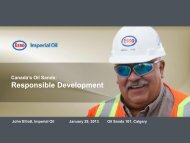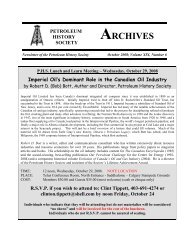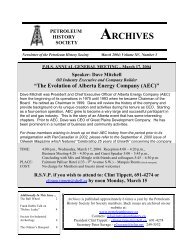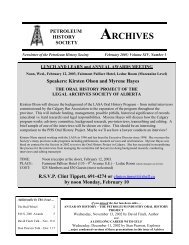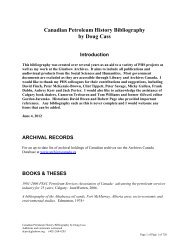PDF format 216k 8 pages - The Petroleum History Society of Canada
PDF format 216k 8 pages - The Petroleum History Society of Canada
PDF format 216k 8 pages - The Petroleum History Society of Canada
Create successful ePaper yourself
Turn your PDF publications into a flip-book with our unique Google optimized e-Paper software.
PETROLEUM<br />
HISTORY<br />
SOCIETY<br />
ARCHIVES<br />
Newsletter <strong>of</strong> the <strong>Petroleum</strong> <strong>History</strong> <strong>Society</strong> March 2011; Volume XXII, Number 2<br />
P.H.S. Annual Meeting and Awards – Wednesday, March 30, 2011<br />
<strong>Petroleum</strong> <strong>History</strong> <strong>Society</strong> A.M. featuring speaker<br />
R.W. (Bob) Taylor and the 2010 P.H.S. Awards<br />
We will be continuing tradition <strong>of</strong> combining our annual <strong>Society</strong> business with a highlighting,<br />
through our annual awards program, <strong>of</strong> individuals and organizations that have made<br />
significant contributions to the preservation <strong>of</strong> Canadian <strong>Petroleum</strong> <strong>History</strong> during 2010.<br />
Our Keynote Speaker will be well known Calgary oilman Bob Taylor who will address us on<br />
the topic “Peak What? Recurring Patterns in the Gas Business”.<br />
<strong>The</strong> schedule for the meeting will be:<br />
4:00 p.m. Meeting commences – call to order<br />
4:05 p.m. President’s Report<br />
4:20 p.m. Treasurer’s Report and related business<br />
4:30 p.m. Election <strong>of</strong> P.H.S. Officers and Board for the 2011-2012 term<br />
4:45 p.m. 2010 P.H.S. Awards<br />
5:15 p.m. Keynote Speaker Bob Taylor (see page 4)<br />
5:45 p.m. Questions, Answers and Discussion<br />
6:00 p.m. Mix and Mingle with snacks and cash bar - Please come out and join us!<br />
TIME: 4:00 p.m., Wednesday, March 30, 2011.<br />
PLACE: Calgary <strong>Petroleum</strong> Club, 319 – 5th Avenue S.W. – Viking Room<br />
COST: Members and Guests (most welcome) - free <strong>of</strong> charge<br />
DRESS: Business casual at minimum, ties not required<br />
For the sake <strong>of</strong> our snack planning, please<br />
R.S.V.P. if you wish to attend to: Micky Gulless at 403-283-9268<br />
or micky@petroleumhistory.ca by noon Monday, March 28
THE PETROLEUM HISTORY SOCIETY<br />
THE BULL WHEEL<br />
Next Luncheons: Following the Annual Meeting, our next event is our luncheon scheduled for<br />
May 4. Our speaker will be Roy Lindseth who will be speaking about the early days in the<br />
Canadian geophysical industry. For subsequent luncheons we are always seeking speakers and<br />
interesting subjects. If you are considering making a presentation, please contact Clint Tippett,<br />
President P.H.S., at 403-691-4274.<br />
Call for Nominations – Board and Executive: In preparation for the Annual Meeting, this is a<br />
final call for anyone who might be interested in joining the Board or Executive <strong>of</strong> the <strong>Society</strong>. If<br />
you would be interested in running, please contact P.H.S. Vice-President Bob Rintoul, who is<br />
coordinating the assembly <strong>of</strong> the slate for the election, at 403-251-9698.<br />
Canadian Centre for Energy In<strong>format</strong>ion: <strong>The</strong> P.H.S. has a “Content, Marketing and Traffic<br />
Partnership” with the Centre. This arrangement is an expression <strong>of</strong> the mutually beneficial<br />
cooperation that exists between our two organizations. Please see www.centreforenergy.com for<br />
more details. Of particular interest to our members is their on-line historical volume “Evolution <strong>of</strong><br />
<strong>Canada</strong>’s Oil and Gas Industry” that can be downloaded free <strong>of</strong> charge.<br />
Glenbow Film Restoration Project: Through the initiative <strong>of</strong> P.H.S. Treasurer and thanks to<br />
five generous members, the <strong>Petroleum</strong> <strong>History</strong> <strong>Society</strong> was able to donate $1250 to the Glenbow<br />
Archives towards conversion <strong>of</strong> their nitrate films to modern media (DVD). We have covered the<br />
cost <strong>of</strong> converting Reel 2 <strong>of</strong> the 1925 silent movie gem called "<strong>Petroleum</strong>, Alberta's Newest<br />
Industry" made by the Canadian Pacific Railway and the Canadian Department <strong>of</strong> Immigration<br />
and Colonization. Hopefully we will be able to see this film sometime in 2011. <strong>The</strong> funds should<br />
also help convert another 1.5 <strong>of</strong> the 10 old films that are on nitrate stock. Thank you – and please<br />
feel free to continue contributing to this very worthwhile historical initiative!<br />
Cultural Highlight: Last November it was reported that UNESCO was in the process <strong>of</strong><br />
expanding its list <strong>of</strong> “intangible world heritage”. This was established to preserve the world’s art<br />
forms and traditions from the “onslaught <strong>of</strong> globalization”. One <strong>of</strong> these cultural treasures has<br />
been identified as Turkey’s “slippery art <strong>of</strong> oil wrestling” which will now stand tall beside more<br />
traditionally-recognized legacies as the Acropolis and the Great Barrier Reef.<br />
<strong>Petroleum</strong> <strong>History</strong> <strong>Society</strong> Archives, March 2011, Volume XXII, Number 2 Page 2
<strong>Society</strong> Bylaw Amendments Proposed: At our upcoming Annual Meeting on March 30, we will<br />
be proposing amendments to our bylaws to increase the maximum number <strong>of</strong> Directors. Currently<br />
it is 6 to 8 directors, and we propose to change that to 6 to 12. We also propose to allow Board<br />
meetings by electronic means (email, telephone) although we don’t plan to replace face-to-face<br />
Board meetings. <strong>The</strong>re will also be some housekeeping items. More in<strong>format</strong>ion will be provided<br />
(probably on our website) before the Annual Meeting and complete bylaws will be available at the<br />
Annual Meeting.<br />
Go paperless – get your Archives newsletter by email only: If you get your Archives by<br />
<strong>Canada</strong> Post, please consider switching to e-mail only. You will receive a printable <strong>PDF</strong> a little bit<br />
sooner than by post, with live links and some photos in colour. E-mailing saves us 59 cents per<br />
copy PLUS all the time, effort and supplies to make labels (done by Micky Gulless), buy stamps<br />
and prepare the envelopes – done by Clint Tippett, our busy P.H.S. President and Archives<br />
Editor. To opt in to email only, please advise Micky at micky@petroleumhistory.ca.<br />
Oilweek Byline - by Industry Executive Dave Yager on matters affecting oil and gas<br />
Goop to Gold: <strong>History</strong> project seeks to enshrine the story <strong>of</strong> the Oilsands<br />
Made a few bucks on the oilsands? <strong>The</strong> total wealth created turning this goop into money is likely<br />
in the hundreds <strong>of</strong> billions. Through jobs, shares in oilsands developers, real estate, lower taxes<br />
through Crown royalties, or owning one <strong>of</strong> the myriad <strong>of</strong> companies that supported the<br />
development <strong>of</strong> the oilsands and Fort McMurray, millions <strong>of</strong> people have benefitted directly or<br />
indirectly. Now two <strong>of</strong> Alberta’s dedicated oil historians – Peter McKenzie-Brown and Robert Bott<br />
– want us to give a little back. <strong>The</strong>y’re raising $150,000 to fund the oilsands component <strong>of</strong><br />
Alberta’s ongoing oral petroleum history project. Because it is the recorded recollections <strong>of</strong> the<br />
pioneers, this project has some urgency. Commercial production at Great Canadian Oil Sands<br />
(now Suncor) began in 1967 and Syncrude in 1978, 43 and 32 years ago respectively. If many <strong>of</strong><br />
the pioneers are still alive, they’re likely not buying many green bananas. Alberta’s oral oil history<br />
is an undertaking <strong>of</strong> <strong>The</strong> <strong>Petroleum</strong> <strong>History</strong> <strong>Society</strong> (www.petroleumhistory.ca), a not-for-pr<strong>of</strong>it<br />
organization that since 1981 has been recording the lives, work and adventures <strong>of</strong> the oilpatch<br />
pioneers who built our industry. To date 307 people have provided their version <strong>of</strong> how we got<br />
this far. Two notable but deceased early interviewees were Carl O. Nickel (founder <strong>of</strong> the Daily<br />
Oil Bulletin) and Jack Gallagher (founder <strong>of</strong> Dome <strong>Petroleum</strong>). <strong>The</strong> history <strong>of</strong> the oilsands is<br />
absolutely fascinating. My favourite read thus far is Black Gold with Grit, <strong>The</strong> Alberta Oil Sands<br />
written by J. Joseph Fitzgerald and in published in 1978. He described himself as GCOS’s main<br />
“man in the field” during the construction <strong>of</strong> the first commercial oilsands plant which began in<br />
1962. He found his way to Fort McMurray in the 1950s as a young man and, like many, became<br />
captivated by its potential. He spent most <strong>of</strong> the rest <strong>of</strong> his working life turning the dream <strong>of</strong> so<br />
many into commercial reality. (Article continues next page)<br />
Archives is published approximately eight times a year by the <strong>Petroleum</strong> <strong>History</strong> <strong>Society</strong><br />
for <strong>Society</strong> members.<br />
Archives is copyright to the PHS – all rights reserved.<br />
Back issues are archived on our website at www.petroleumhistory.ca<br />
Contacts: info@petroleumhistory.ca<br />
President: Clint Tippett – clinton.tippett@shell.com 403-691-4274<br />
Secretary: Helen Turgeon – heldon@telus.net 403-239-4863<br />
<strong>Petroleum</strong> <strong>History</strong> <strong>Society</strong> Archives, March 2011, Volume XXII, Number 2 Page 3
What makes Fitzgerald’s book relevant to the foregoing is that the book is in many ways his oral<br />
history, a combination <strong>of</strong> history, facts and his observations <strong>of</strong> what it took to get GCOS and<br />
Syncrude started.<br />
Fitzgerald’s account starts in 1719 when a native Cree from this region brought an oilsands<br />
sample to the famous York Factory Hudson’s Bay Company trading post (on Hudson Bay). <strong>The</strong><br />
report that there existed oil that oozed out <strong>of</strong> sand in western <strong>Canada</strong> found its way back to<br />
England. Independent American trader Peter Pond found his way to the oilsands region in 1778.<br />
Explorer Alexander Mackenzie followed in 1788.<br />
<strong>The</strong> Geological Survey <strong>of</strong> <strong>Canada</strong> got its first oilsands report on file following an expedition in<br />
1875. Having witnessed vast amounts <strong>of</strong> oil oozing out <strong>of</strong> the riverbanks, a forward-thinking<br />
geologist wrote about lying awake dreaming <strong>of</strong> the day, “…when the white man would be busy,<br />
with his ready instrument, steam, raising the untold wealth which lied beneath the surface, and<br />
converting the present desolation into a bustling mart <strong>of</strong> trade”.<br />
Steam. Somebody thought <strong>of</strong> that 135 years before today’s SAGD boom.<br />
With an <strong>of</strong>ficial government report on file, the boom was on. Fitzgerald describes dozens <strong>of</strong><br />
different entrepreneurs with a gleam in their eye trying different methods <strong>of</strong> separating bitumen<br />
from sand. Heat was, and remains, a key ingredient. Much <strong>of</strong> the experimentation took place<br />
before the turn <strong>of</strong> 20 th century.<br />
By 1913 semi-processed oilsands were on their way to Edmonton for testing as asphalt on Fort<br />
Road. <strong>The</strong> Bitumont experimental plant north <strong>of</strong> Fort McMurray, built in the 1920s, is still<br />
standing. <strong>The</strong> operation was taken over by the Alberta government in 1948 and was soon<br />
processing 450 tonnes <strong>of</strong> sand a day. A year later Edmonton lost interest and the plant was<br />
shuttered as a commercial failure.<br />
In the 1960s somebody conceived detonating a small nuclear bomb in the reservoir. Warm and<br />
separated, the oil could then be recovered by conventional means. Fitzgerald’s personal passion<br />
was ultrasound; using high frequency sound waves to separate the hydrocarbons and sand. Alas,<br />
no heat, no success.<br />
He also tells the personal story <strong>of</strong> trying to get into Calgary’s <strong>Petroleum</strong> Club. Oilsands<br />
developers were miners, not drillers, and therefore not eligible for membership. Miners, on the<br />
other hand, said it looked like the oil business to them. Fitzgerald wrote he was, “neither fish nor<br />
fowl”.<br />
Fitzgerald published his book in 1978 after GCOS was on stream and Syncrude was nearing<br />
construction. But he foresaw many <strong>of</strong> today’s environmental issues like tailings ponds and water<br />
use. As for the bitumen itself, he described oilsands development as man doing this best to clean<br />
up nature’s largest oil spills. He passed away in 1991.<br />
Looking at the wealth this resource has and will generate, supporting oilsands oral history project<br />
is the financial equivalent <strong>of</strong> a few grains <strong>of</strong> sand…oil sand. Please help.<br />
(reprinted here with Oilweek’s permission thanks to P.H.S. Director and Oil Sands Oral<br />
<strong>History</strong> Project lead Peter McKenzie-Brown)<br />
<strong>Petroleum</strong> <strong>History</strong> <strong>Society</strong> Archives, March 2011, Volume XXII, Number 2 Page 4
KEYNOTE SPEAKER<br />
P.H.S. ANNUAL MEETING – MARCH 30, 2011<br />
R.W. (Bob) Taylor<br />
Bob’s twenty-nine year corporate career has spanned all aspects <strong>of</strong> the upstream oil and gas<br />
sector from Western <strong>Canada</strong> to <strong>of</strong>fshore Newfoundland, from the deep water Gulf <strong>of</strong> Mexico to<br />
the first <strong>of</strong>fshore drilling in the Beaufort Sea. He filled a variety <strong>of</strong> executive positions in oil and<br />
gas operations in Western <strong>Canada</strong>, culminating in leading two major oil sands development<br />
expansions.<br />
Subsequently Bob served four years as an Assistant Deputy Minister with the Alberta Department<br />
<strong>of</strong> Energy with responsibility for Conventional Oil, Oil Sands, Land Tenure, Land Access and<br />
Energy and Aboriginal Relations. At the same time he served on the Boards <strong>of</strong> the Alberta<br />
Energy Research Institute, the Canadian Energy Research Institute and the Alberta Chamber <strong>of</strong><br />
Resources. He was also Chair <strong>of</strong> the Board for Calgary’s Lunchbox <strong>The</strong>atre.<br />
Since leaving the Department <strong>of</strong> Energy in 2004, Bob has been active in broad range <strong>of</strong> energyrelated<br />
consulting projects including the resolution <strong>of</strong> Alberta’s gas-over-bitumen dilemma; coleading<br />
the Alberta Mega-Project Excellence initiative; assisting in stewarding <strong>Canada</strong>’s interest<br />
in the Hibernia oil project and; advocating for trans<strong>format</strong>ive emerging technologies in the oil<br />
sands sector.<br />
In 2007 Bob joined a group <strong>of</strong> like-minded individuals as a Founding Partner in the not-for-pr<strong>of</strong>it<br />
Energy Futures Network (EFN). <strong>The</strong>ir goal is to enable a fact-based exploration <strong>of</strong> future energy<br />
options for <strong>Canada</strong> and the world. Some EFN projects include working with the companies in the<br />
Oil Sands Leadership Initiative to develop their Charter; with the OSTECH technology<br />
assessment program, facilitating the Zero Waste in the Oil Sands initiative and, in collaboration<br />
with whatIf? Technologies, undertaking several projects examining future possible energy<br />
scenarios for <strong>Canada</strong>. Two <strong>of</strong> these initiatives included assessing the impact <strong>of</strong> unconventional<br />
gas development on <strong>Canada</strong>’s future energy mix.<br />
Bob’s formal education includes a B.Sc. in Chemical Engineering from the University <strong>of</strong><br />
Saskatchewan and participation in the Banff School <strong>of</strong> Advanced Management (BSAM). Currently<br />
Bob continues his learning about and effecting change as an affiliate <strong>of</strong> the both the Innovation<br />
Expedition and the Renaissance Leadership Network.<br />
Bob and his wife, Réjeanne, are very committed long distance walkers and dedicated<br />
photographers, <strong>of</strong>ten combining the two in their numerous international travels. For example,<br />
they have walked across Spain three and a half times following the historic pilgrimage routes.<br />
Passing: <strong>The</strong> March 20 issue <strong>of</strong> the Calgary Herald carried the obituary for an industry pioneer<br />
who perhaps was not well known. John Bohan Maughan was born in Lethbridge in 1925. He<br />
began his career in the oil and gas industry in Turner Valley at the age <strong>of</strong> twelve where he was a<br />
roustabout on the drilling rigs operated by his father and his Uncle “By God” Bill Maughan. After<br />
obtaining his Masters in <strong>Petroleum</strong> Engineering from the University <strong>of</strong> Oklahoma, he worked with<br />
the legendary John Arps in Tulsa and Dallas. He returned to <strong>Canada</strong> with Stanolind Oil/Amoco,<br />
where he was Chief Engineer during the development <strong>of</strong> the Pembina Oil Field. Later he joined<br />
J.C.Sproule at Sproule Consulting as the firm’s first petroleum engineer and was integral in<br />
establishing Sproule as a leading worldwide consulting firm.<br />
<strong>Petroleum</strong> <strong>History</strong> <strong>Society</strong> Archives, March 2011, Volume XXII, Number 2 Page 5
OIL SCOUTS<br />
A Presentation by Derry Macfarlane October 21, 2009<br />
(Continued from the February 2011 issue <strong>of</strong> Archives)<br />
Week two --- Similar scenario - to Red Deer Tuesday evening, up early and down to the<br />
meeting room. <strong>The</strong> Bull called the meeting to order promptly at eight. Glared over to me and<br />
spoke “Mr. Skelly, I see that you are back. Would you be kind enough to report the status <strong>of</strong> your<br />
Glady’s Ridge well.” I had the well ticket opened and gave the status John had given me.<br />
Again the Bull started yelling for me to get to the phone and get a better status. I hustled out <strong>of</strong><br />
the meeting and called John. He asked me, “Who is the Bull Scout?” I didn’t know. <strong>The</strong>n he<br />
said “Well what does he look like?”. I told him he had a huge head <strong>of</strong> wild curly black hair<br />
along with a great large black beard. John told me to write down what I was to report when I went<br />
back in. <strong>The</strong> question was asked. “Mr.Skelly did you get another status?”, to which I answered<br />
yes I did. Will you please enlighten this gathering. I stood up took the ticket in my hand and<br />
stated. I am to tell Frank Dwyer to go shit in his hat. Frank came totally unglued and started<br />
climbing across the table. I had my binders and briefcase and was heading out <strong>of</strong> the room on<br />
the gallop and home even earlier than week one, telling my wife that this was one crazy<br />
pr<strong>of</strong>ession.<br />
Week three --- A couple <strong>of</strong> Scouts got in touch with me and asked if I would be interested in<br />
following them to a Can Sup [Canadian Superior] well drilling east <strong>of</strong> Olds to initiate me into<br />
rig jargon and field scouting. I accepted their <strong>of</strong>fer and the next day away we went. About twenty<br />
miles east <strong>of</strong> Olds we turned down a country road for a few miles and came to the well-site sitting<br />
in a empty summer fallowed field. <strong>The</strong>re were about nine vehicles parked on the roadside and<br />
down in the ditch were three card tables set up. A group <strong>of</strong> guys were playing cards; one was<br />
covered with various bottles <strong>of</strong> fire water, plastic cups and a bag <strong>of</strong> ice. I was quickly<br />
introduced to the mini check members and handed a tasty beverage, my first introduction to some<br />
<strong>of</strong> those attendees at the two previous Red Deer meetings. Not long after, a half ton from the rig<br />
drove over to our group and warned us that nobody should try to come onto the field area. With<br />
the binoculars and scopes the scouts had, and the area wide open there was no need to get any<br />
closer. Sometime in the late afternoon a couple <strong>of</strong> reminder gunshots were fired over our<br />
heads from the rig.<br />
A card table meeting was called and it was found that among those present there were about<br />
eight shotguns and rifles available and a hoax was arranged. <strong>The</strong> plan was two weapons<br />
would be spaced on each <strong>of</strong> the four sides <strong>of</strong> the quarter section and at five minutes after eight<br />
o’clock each gun would be fired into the air. At five minutes passed eight the barrage was<br />
fired. It was chaos on the rig, men were sliding down the vee-doors, scrambling down the<br />
stairways and running in the dark over the fallowed field. <strong>The</strong> scouting party had earlier been<br />
loaded up and we all quickly departed en-mass for Red Deer.<br />
Now I was totally convinced that scouting guys were a very strange group unto their own.<br />
<strong>The</strong>re were a number <strong>of</strong> veteran members still present in my early years, Jim Seymour,<br />
Bill Allen, Jack Orman, Jim Thompson, Mac Buffam, Porky Brown, to name a few.<br />
<strong>The</strong> job <strong>of</strong> the scout was to gather and assimilate in<strong>format</strong>ion for the use <strong>of</strong> their company.<br />
Scout checks were an agreed in<strong>format</strong>ion swap <strong>of</strong> dope by the member companies. <strong>The</strong> wells<br />
<strong>Petroleum</strong> <strong>History</strong> <strong>Society</strong> Archives, March 2011, Volume XXII, Number 2 Page 6
<strong>of</strong> non-member companies were also assigned to the sitting members. That member was then<br />
responsible to, attempt to scrounge out that firms operations. When a member company drilled<br />
in the vicinity <strong>of</strong> Crown sale parcels, the scout could apply for a “Tight Hole Status“, and if<br />
approved, was not responsible to report on the well. Usually another member was then<br />
assigned to come up with some kind <strong>of</strong> status report. Field scouting usually was a result <strong>of</strong> sale<br />
postings. If your company was drilling in the same vicinity or had a geological or geophysical<br />
play in the area, the well may be “field scouted”. ----- Secrecy was a factor, --- thus the<br />
espionage aspect. <strong>The</strong>re was no end <strong>of</strong> capers and wild occurrences. Bear scares, a<br />
helicopter crash, conflicts with drilling personal, they continued through my entire thirteen years <strong>of</strong><br />
scouting. So numerable that to compile them and write <strong>of</strong> them would make a fair sized book. In<br />
a personal book that I wrote and had published, the scouting chapter I titled “<strong>The</strong> Industrial<br />
Spies”, a name that a guest speaker in his talk at one <strong>of</strong> our conventions labeled us with, truly<br />
somewhat very appropriate. A couple <strong>of</strong> my personal exploits may draw home some <strong>of</strong> the<br />
bazaar hazards <strong>of</strong> many scouts.<br />
Skelly was drilling a hole on the north side <strong>of</strong> Lesser Slave Lake. Crown land had been posted<br />
and on the other side <strong>of</strong> the posting Amoco were also drilling. It was the norm when planning<br />
to scout a well that you try to time your secret arrival at the site just prior to the down hole<br />
activity, preferably before core point. I arrived at our site around three and got my gear unloaded<br />
into the engineer/geologist trailer, the temperature was 35 to 40 below. I decided to drive over<br />
and walk into the Amoco well to plan my attack schedule. I crawled into my thermal underwear,<br />
flannel undershirt second shirt and heavy sweater. Put on my lined airman pants and top<br />
jacket, lined flight boots and informed my hosts that I was just going to take a quick peek at the<br />
other rig. I parked my car about a mile north <strong>of</strong> my target and began the trek in. During the<br />
whole walk in I kept hearing noises in the woods beside me and surmised that it was probably<br />
deer or coyotes. When I arrived near the rig I looked through my binoculars and was totally<br />
surprised that they were pulling a core barrel out <strong>of</strong> the hole. This changed the whole plan as it<br />
was imperative that I tally them back in to calculate the depth. Normally I would have crawled<br />
into my five-star sleeping bag just peeking out with my binoculars but that wasn’t going to<br />
happen. <strong>The</strong>y put a drill bit on and started back in. I tallied as the hours went by, shifting from<br />
foot to foot and slapping myself. My hands were the worst, even with gloves on inside the eider<br />
down lined outer gloves. Finally they bottomed and I started back to the car hearing again<br />
rustling in the woods. I arrived at the car, managed to get the key but my fingers couldn’t turn<br />
it. I put the key between the wrist part <strong>of</strong> the palms and did get it to open the door. In the car I<br />
had the same problem with the ignition, thinking that if this doesn’t start I‘m a goner. <strong>The</strong> key<br />
turned, the engine groaned. One more try, the key turned and the engine fired. I didn’t even<br />
consider warming the car up, I knew I had to get to our camp. I put the lights on and three big<br />
wolves were directly in front <strong>of</strong> the car. <strong>The</strong> three or four mile drive was brutal. I could hardly<br />
hold the wheel, and very little vision as the windows were iced over. I made it to camp,<br />
struggled into the trailer thinking that I would go right into a hot shower clothes and all. But<br />
immediately my whole system went haywire, I tried to say that I was freezing but the words<br />
came out gobbley-goop. <strong>The</strong> engineer immediately yelled at the geologist to get some<br />
blankets as he wrestled me to the floor, I was fighting him all the way thinking he was doing<br />
me in. <strong>The</strong>y controlled my wild arm swinging, rolled me in blankets and one sat on me. After<br />
painfully thawing out, the engineer explained that he had been privy to a similar experience once<br />
before. <strong>The</strong> next day a game warden came by and asked if any wolves had been seen. He<br />
informed us that the wolves were starving and had followed a herd <strong>of</strong> caribou trying to get them<br />
out onto Utikuma Lake where the open area would be easier for them to knock down their prey.<br />
To be continued<br />
<strong>Petroleum</strong> <strong>History</strong> <strong>Society</strong> Archives, March 2011, Volume XXII, Number 2 Page 7
Drilling Rig on Ratawi #1, Iraq 1949 (Terry Storey photograph)<br />
Local Guards on Ras Sadr #1 wellsite, Abu Dhabi 1950 (Terry Storey photograph)<br />
<strong>Petroleum</strong> <strong>History</strong> <strong>Society</strong> Archives, march 2011, Volume XXII, Number 2 Page 8



